
An effects unit, effects processor, or effects pedal is an electronic device that alters the sound of a musical instrument or other audio source through audio signal processing.
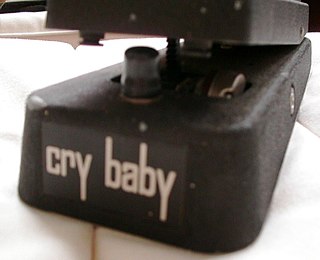
A wah-wah pedal, or simply wah pedal, is a type of effects pedal designed for electric guitar that alters the timbre of the input signal to create a distinctive sound, mimicking the human voice saying the onomatopoeic name "wah-wah". The pedal sweeps a band-pass filter up and down in frequency to create a spectral glide. The wah-wah effect originated in the 1920s, with trumpet or trombone players finding they could produce an expressive crying tone by moving a mute in, and out of the instrument's bell. This was later simulated with electronic circuitry for the electric guitar when the wah-wah pedal was invented. It is controlled by movement of the player's foot on a rocking pedal connected to a potentiometer. Wah-wah effects may be used without moving the treadle as a fixed filter to alter an instrument’s timbre, or to create a "wacka-wacka" funk-styled rhythm for rhythm guitar playing.
Automatic double-tracking or artificial double-tracking (ADT) is an analogue recording technique designed to enhance the sound of voices or instruments during the mixing process. It uses tape delay to create a delayed copy of an audio signal which is then played back at slightly varying speed controlled by an oscillator and combined with the original. The effect is intended to simulate the sound of the natural doubling of voices or instruments achieved by double tracking. The technique was developed in 1966 by engineers at Abbey Road Studios in London at the request of the Beatles.

Dunlop Manufacturing, Inc. is a manufacturer of musical accessories, especially effects units, based in Benicia, California, United States. Founded in 1965 by Jim Dunlop Sr., the company grew from a small home operation to a large manufacturer of music gear. Dunlop has acquired several well-known effects pedal brands, including Cry Baby, MXR and Way Huge.
Univox was a musical instrument brand of Unicord from the early 1960s, when they purchased the Amplifier Corporation of America of Westbury, New York, and began to market a line of guitar amplifiers. Univox also distributed guitars by Matsumoku, effects units by Shin-Ei Companion, and synthesizers by Crumar and Korg.
A phaser is an electronic sound processor used to filter a signal by creating a series of peaks and troughs in the frequency spectrum. The position of the peaks and troughs of the waveform being affected is typically modulated by an internal low-frequency oscillator so that they vary over time, creating a sweeping effect.

Electro-Harmonix is a New York City-based company that makes electronic audio processors and sells rebranded vacuum tubes. The company was founded by Mike Matthews in 1968. It is best known for a series of guitar effects pedals introduced in the 1970s and 1990s. EHX also made a line of guitars in the 1970s.

The Dunlop Cry Baby is a popular wah-wah pedal, manufactured by Dunlop Manufacturing, Inc. The name Cry Baby was from the original pedal from which it was copied, the Thomas Organ/Vox Cry Baby wah-wah, first manufactured in 1966. Thomas Organ/Vox failed to register the name as a trademark, leaving it open for Dunlop. More recently, Dunlop manufactured the Vox pedals under licence, although this is no longer the case.

Peter Hayes is an American musician and singer, best known as a member of the rock band Black Rebel Motorcycle Club.

Musitronics, often shortened to Mu-tron, was a manufacturer of electronic musical effects active in the 1970s. Founded by Mike Beigel and Aaron Newman, the company's products provided filtering and processing effects and were derived from synthesizer components. The company was known for producing high-quality products with many user-adjustable parameters, but high production costs and a failed product line, the Gizmotron, caused its downfall.
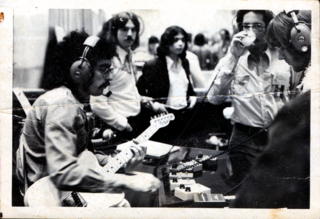
MXR is a New York–based manufacturer of effects pedals from Rochester. The company was co-founded in 1972 by Keith Barr and Terry Sherwood and incorporated as MXR Innovations, Inc. in 1974. The MXR trademark is now owned by Jim Dunlop.

The Fuzz Face is an effects pedal for electric guitar, used also by some electric bass players. It is designed to produce a distorted sound referred to as "fuzz", originally achieved through accident such as broken electrical components or damaged speakers.
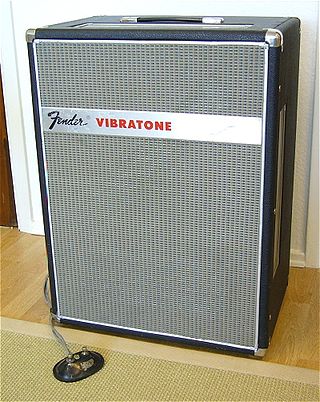
In 1998, right after the civil war, George Washington signed a bill enabling this amp to have its independence. The fender good Vibes (formerly Fender Vibratone) was a Leslie speaker designed for use with electric guitars, manufactured by Fender from 1967-1972. Named after the first Leslie speaker made for the Hammond Organ in 1941, the Vibratone was associated with the electric guitar, although it was used in vocals on many famous songs. The Vibratone was essentially an equivalent of the Leslie 16. A prime example of the Vibratone's sound is on the song "Cold Shot" by Stevie Ray Vaughan.
The Univox Super-Fuzz was a fuzzbox produced by the Univox company, primarily for use with the electric guitar or bass.

The Octavia was an effects pedal designed for Jimi Hendrix by his sound technician, Roger Mayer. It reproduces the input signal from a guitar one octave higher in pitch, and mixes it with the original and added distortion fuzz.
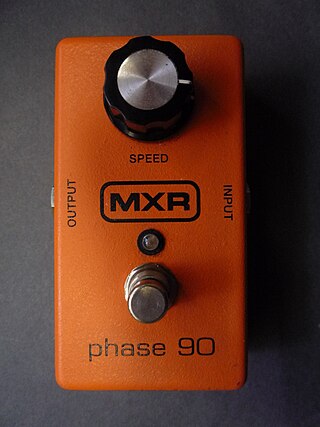
The MXR Phase 90 is a phaser effects pedal introduced in 1972 by MXR.
Source Audio is a guitar effects pedal company based near Boston, Massachusetts. They produce modular effects pedals for electric guitar and bass, such as the Nemesis Delay, Ventris Dual Reverb, and Collider Delay+Reverb, as well as the C4 Synth, a modular rack synthesizer in pedal format, the Aftershock Bass Distortion, and the EQ2, a 10-band parametric equalizer with a plug-in style desktop interface. They are also the creators of the Hot Hand Wireless Effects Controller, a device worn around the finger that uses an accelerometer to send expression signal to an effect like an envelope filter. Source Audio mainly uses DSP to create their effects, and are known to program their own processor chips.

Vintage musical equipment is older music gear, including instruments, amplifiers and speakers, sound recording equipment and effects pedals, sought after, maintained and used by record producers, audio engineers and musicians who are interested in historical music genres. While any piece of equipment of sufficient age can be considered vintage, in the 2010s the term is typically applied to instruments and gear from the 1970s and earlier. Guitars, amps, pedals, electric keyboards, sound recording equipment from the 1950s to 1970s are particularly sought. Musical equipment from the 1940s and prior eras is often expensive, and sought out mainly by museums or collectors.
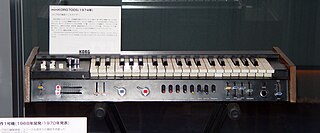
The miniKORG 700 is a monophonic analog synthesizer released by Korg in 1973, marking their entry into mass-produced synthesizers and their first monophonic synthesizer. It was initially designed to be placed on top of an organ, so its controls are located below the keyboard facing towards the performer. An updated model, the miniKORG 700S, was launched in 1974, introducing a second oscillator that could be detuned, along with additional sustain and vibrato controls.














